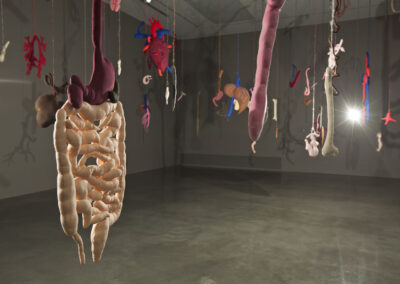Our latest Artist You Need To Know is Annette Messager, and she has offered the following insightful observations about her artwork and aesthetic: “For me, it’s a ‘natural’ gesture to rip bodies apart, cut them up. I always feel that my identity as a woman and as an artist is divided, disintegrated, fragmented, and never linear, always multifaceted…always pictures of parts of bodies, fragments and closeups …I always perceive the body in fragments.” She said this in response to her installation Les Piques {The Pikes} (1992 – 93), and we’ve included some images of that work below. Much more about that artwork, which has often changed form, and been split into multiple incarnation as well, can be read here.
-

The Pikes, 1992-3
-

Detail, The Pikes, 1992-3
-

Detail, The Pikes, 1992-3
-

Detail, The Pikes, 1992 - 93
-

Detail, The Pikes, 1992 - 93
-

Detail, The Pikes, 1992 - 93
Annette Messager is a well known and appropriately lauded contemporary French installation artist whose art often examines “conventional perceptions of women by individuals and by society at large. Her early pieces focused on domestic objects such as textiles, toys, and found objects, and through her later work the artist has continued to question traditional notions of femininity and masculinity. “At first, I felt proud when someone said, ‘Your work looks like a man did it.’ Then I realized that was stupid,” the artist once quipped.” (from here, where you can see many more of her works, as well. Considering the detailed and evocative nature of her work, or the environments she’s created, details are necessary for a full appreciation, and can be found at the numerous links we’re including. Here’s a brief video of a work by Messager, installed at Villa Medici, and a more in depth conversation about an exhibition of numerous works by the artist in Calais, France).
-

Sleeping Heart, 2017
-

Sleeping Purple Passion, 2018
-

Sleeping Deep Red, 2017 - 2018
-

Emotion, 2017
-

Utérus doigt d’honneur (Uterus Giving the Finger), 2017
-

Jalousie / Love, 2010
Born on November 30, 1943 in Berck, France, Messager attended the École des Arts Décoratifs in Paris. Her resume is beyond impressive. In 2005, she won the Golden Lion Award at the Venice Biennale for her installation which transformed the French pavilion through a variety of moving sculpture, notably including Casino (2005), in which a wind machine creates waves and ripples in a large red silk sheet amongst strange creatures and forms. She has also had numerous solo exhibitions around the world: sevearl notable ones include the Museo de Arte Moderno in Buenos Aires, the Musée d’Art Moderne de la Ville de Paris, and a retrospective at the Centre Pompidou in Paris.
-

Mes Voeux, 1988
-

Voeux triangle (tentation), 1989
-

3 fusils badges, 2007
-

Pénétration [Penetration] 1993-94
-

Casino Pinocchio la baleine/the whale (Dessous), 2004-2005
-

Mes Ouvrages (Possession), 1998
Several critics and curators have offered engaging commentary on Messager’s artwork. From the Marian Goodman Gallery (which has an extensive selection of her art): “Often using reminiscence and memory as a vehicle for inspiration, Messager’s wide range of hybrid forms has had an affinity with traditions as varied as the romantic, the grotesque, the absurd, the phantasmagoric.” An article in The Guardian, in 2017, described Messager’s aesthetic, as having “moments of typically mischievous affront….[but] it wants to speak as simply and pungently as possible.”
As previously mentioned, the Marian Goodman Gallery is an excellent resource online for Messager’s work. From the Goodman Gallery: “Messager was awarded the Praemium Imperiale for sculpture in 2016. She won the Golden Lion for best national pavilion at the 51st Venice Biennale in 2005. The Tel Aviv Museum of Art will present a major exhibition of her work in 2022. Recently she has exhibited at the Institut Giacometti in Paris (2018), the Institut Valencià Art Modern (IVAM) in Spain (2018), and the Villa Medici in Rome (2017). In France, an important exhibition was put in at the Musée des Beaux-Arts and at the Cité de la Dentelle et de la Mode in Calais, in 2015–16. In 2014 Messager had major exhibitions at the Museum of Contemporary Art MCA, Sydney, and at K21 in Düsseldorf. Earlier solo shows have been exhibited at the Museo de Arte Contemporáneo in Monterrey (MARCO), Mexico (2011); the Hayward Gallery in London (2009); the Espoo Museum of Modern Art (EMMA), Finland (2008); the National Museum of Contemporary Art, Seoul, South Korea (2008); and the Mori Art Museum in Tokyo (2008). A major retrospective of her work was organised by the Centre Pompidou, Paris, in 2007.”
Messager currently lives and works in Malakoff, France.The 1968 student revolution in France can be seen as being formative in her approach to art and art making, provoking both a rigorous skepticism about art and a focus on the conceptual potential and boundaries of the same. She is regarded by many in Europe as one of the key artists of her generation.




















